E-bikes have been around longer than one might think. The first U.S. patent for a battery-powered bicycle was awarded in 1895. Today, of the world’s one billion bicycles about 40 million of them are electric bikes and they are being ridden by all types of riders and for many different reasons—including hunting.
Hunters are turning to e-bikes because they can cover more distance faster and more efficiently. E-bikes do not produce as much noise as ATVs or dirt bikes, and they can help carry gear or game with little effort. If you’re considering adding an e-bike to your scouting and hunting strategy this year, check out the ins, outs, and first-hand accounts of the electric bike.
What Is an Electric Hunting Bike?
E-bikes are bicycles that use rechargeable battery power to assist the rider with pedaling, or in some cases, to help propel the bicycle with a throttle control. “Pedal assist” e-bikes use a small motor that runs when a rider begins pedaling. “Throttle control” e-bikes can be powered by pressing or twisting a control, with no pedaling required.
The speed each e-bike is capable of reaching defines the class in which it belongs, but more on e-bike classifications to follow. Generally, e-bikes can reach speeds up to 20 MPH. E-bikes in a higher class can reach speeds of 28+ MPH.
There are some qualities of hunting e-bikes that set them apart from typical e-bikes. One of the most notable differences is tire size. Consider QuietKat’s Apex Pro, pictured below, as this e-bike is designed for hunting and features tires that are 26” x 4.5”. Additional features of hunting e-bikes are their rugged frame construction and suspension. This allows these bikes to haul gear and game and traverse a variety of terrain. They are also designed to rig with accessories like trailers, extra lighting, weapon racks, and storage solutions.
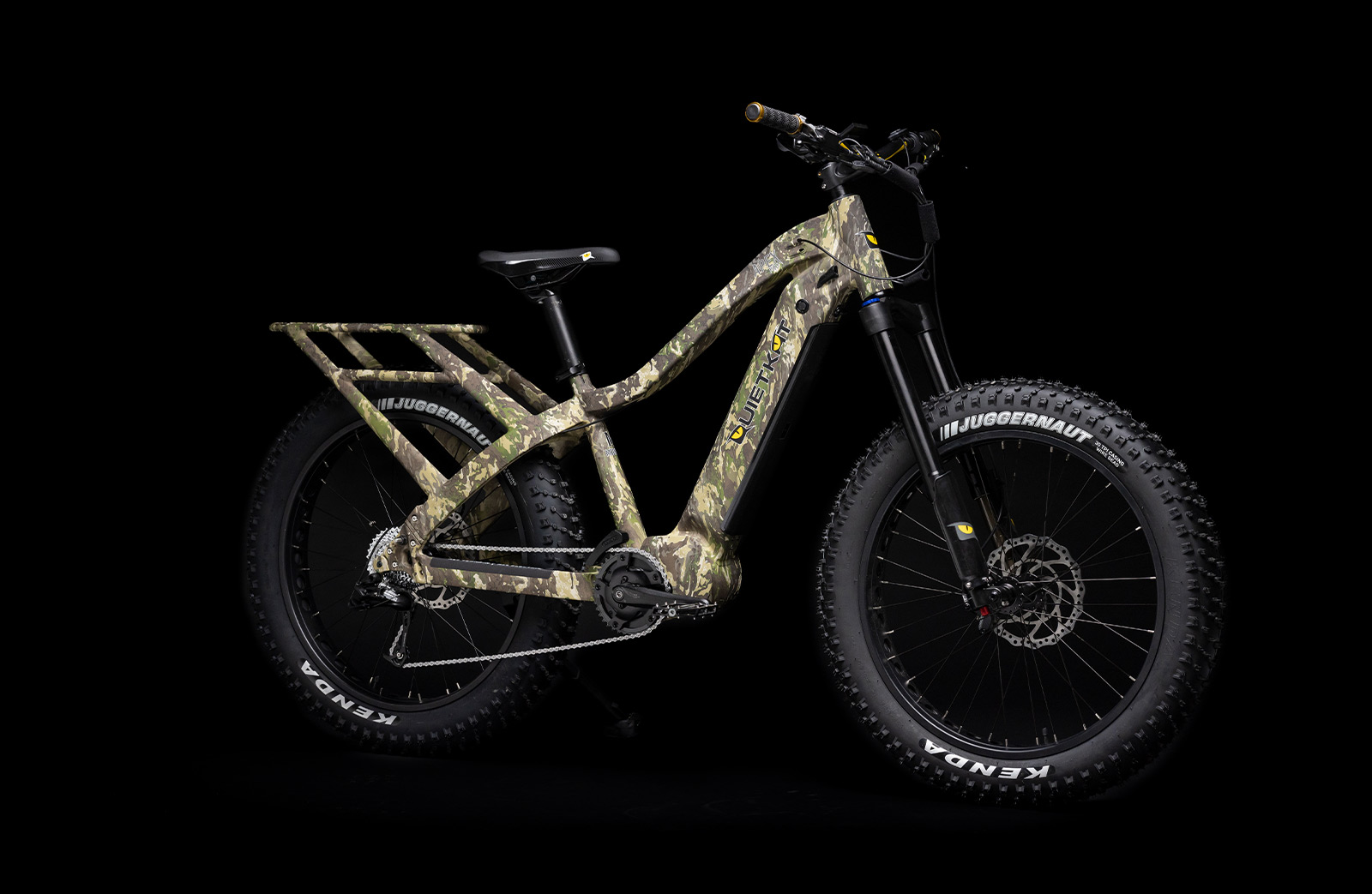
What Are E-Bike Classifications?
In 2020, e-bike regulations began getting established in about half of the U.S. Now accepted in over 40 states, these regulations were meant to help define what e-bikes were. Were they motor vehicles? Were they bicycles? Where did they belong: in bike lanes, on trails, on roads? While not all those questions are yet perfectly defined, and it’s always best to check with your local government or land agencies to confirm legality, there has been a generally-accepted classification system put on e-bikes. Here’s what that looks like:
Class 1 E-Bikes
E-bikes designated as Class 1 have a maximum speed of 20 MPH and their motors only engage as “pedal assist,” meaning they typically have no throttle control to operate by hand.
Class 1 e-bikes are commonly allowed on bike paths and in bike lanes that are shared with traditional, non-motorized bicycles.
Class 2 E-Bikes
E-bikes designated as Class 2 have the same 20 MPH max speed, but they include a throttle control that can propel the bike without pedaling. However, Class 2 e-bikes typically have “pedal assist” as well.
Like Class 1 e-bikes, these can be ridden on bike paths and in bike lanes.
Class 3 E-Bikes
The main difference with Class 3 e-bikes is that they have a top speed of 28 MPH, but they must also have a speedometer. They may or may not have throttle control. In fact, currently in California Class 3 e-bikes are only allowed without throttle controls, must be “pedal assist” only, and the rider must be at least 16 years old and wear a helmet.
When Class 3 e-bikes do include a throttle, they are often limited to 20 MPH max speed by the throttle alone, even though the bike can go faster when the rider is pedaling.
Most states allow Class 3 e-bikes in road lanes and in bike lanes on the shoulder of the road, but they are typically restricted from bike paths that occur off roadways or on multi-use trails shared with pedestrians.
So what do you do if you’re traveling with your e-bike to hunt in another state where e-bike regulations differ from your home state? Some e-bike manufacturers offer modes on their bikes that limit speeds. QuietKat e-bikes, for instance, have Variable Power Output (VPO™) technology that lets riders adjust output parameters to match where they ride. These bikes can be toggled between Class 1, 2, 3, or unlimited.
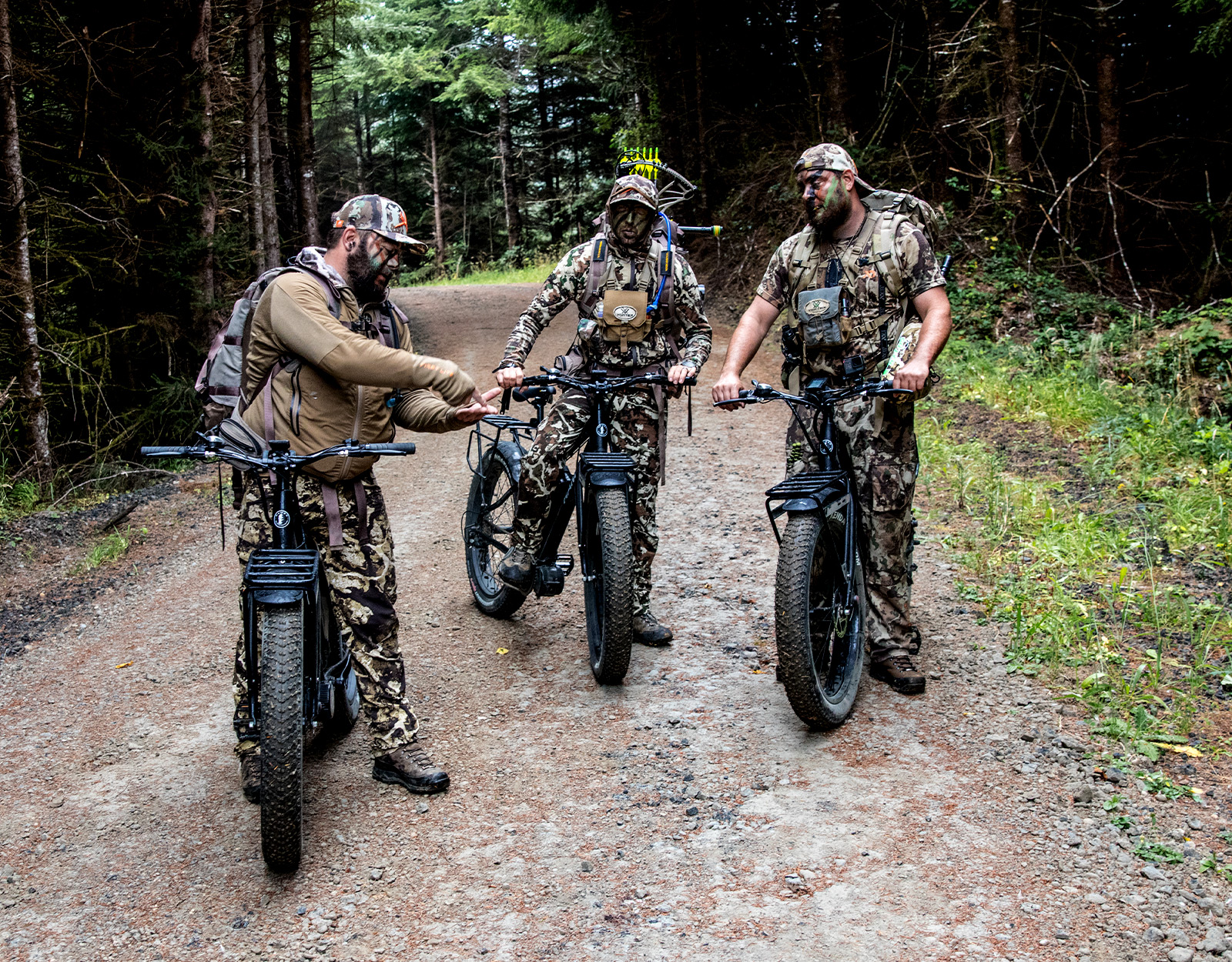
E-Bike Regulations and Trail Usage
With the understanding of how e-bikes work and how they are classified, it’s time to layer on a deeper level of e-bike regulations, especially for taking them to the places people hunt—in the woods, mountains, and on public lands.
The BLM has one of the most clear stances on e-bikes. The BLM states simply: “BLM-managed public lands offer many opportunities for riding e-bikes, including any Open OHV area or motorized trail.” There are 215 OHV areas on BLM’s website. These areas can also be found in the onX Offroad App.
As for riding an e-bike on other federal public lands, like national forests and national parks, the same general guidelines apply: stick to roads and trails where you’ll also find cars, camper vans, motorcycles, and other motorized vehicles. The USDA Forest Service considers e-bikes as motorized vehicles and as such does not allow their use on non-motorized National Forest System roads and trails.
Interestingly, throttle controls on Class 2 and Class 3 e-bikes are also not allowed to be used when on a trail in a national park; a rider must pedal as if riding a Class 1 e-bike.
Wilderness areas, of course, are off-limits to all bicycles, motorized or not.
When it comes to lands managed by local or state governments, e-bike regulations vary widely, so it’s always important to check before you ride. In many state parks e-bikes are allowed on the same trails as standard bicycles are allowed.
These regulations are changing constantly, so what is closed this year may be open the next, and vice versa.
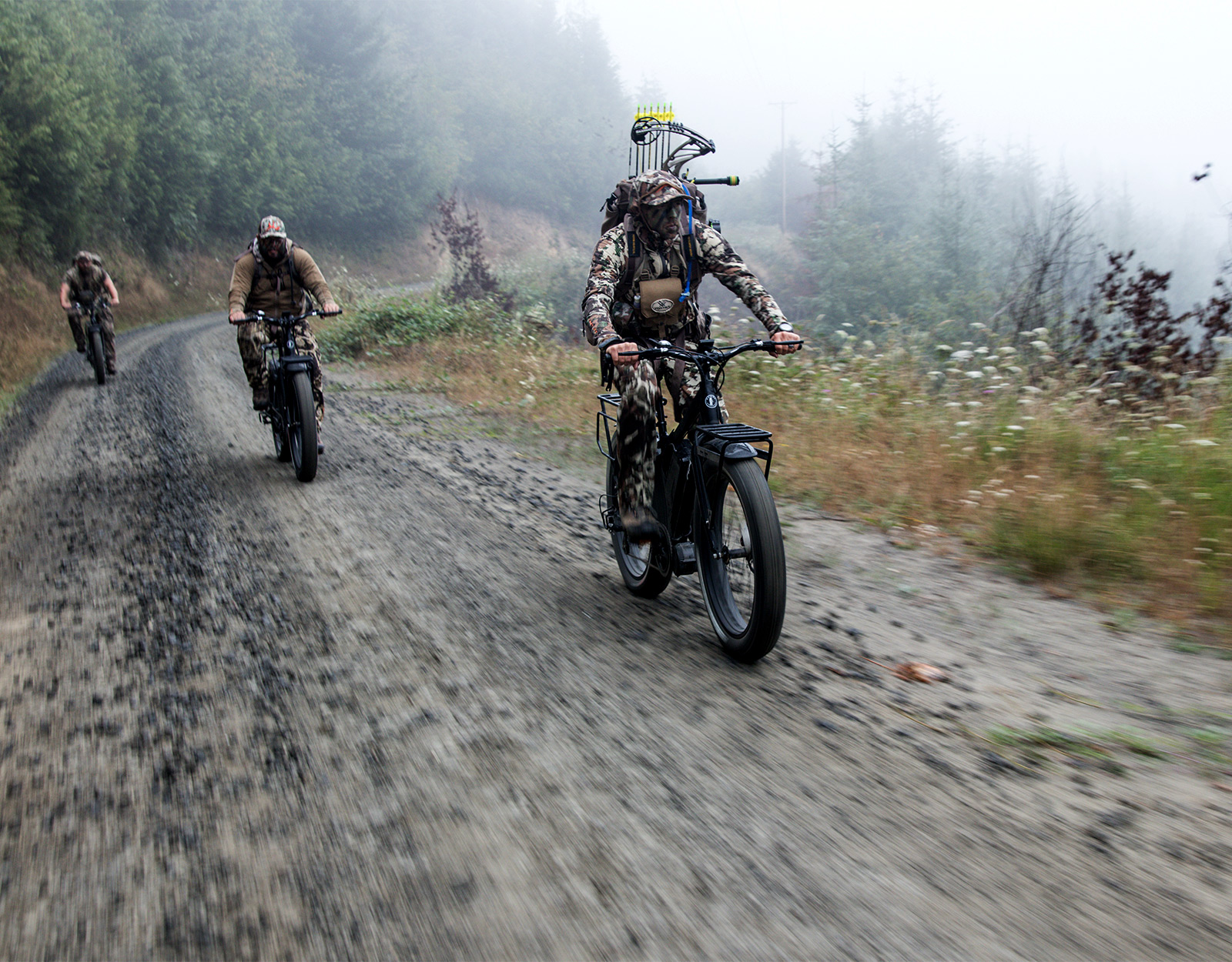
Some Considerations for First-Timers
Riding a bike is like…well, riding a bike. But even accomplished bicycle riders should spend time getting used to the nuances of e-bikes. Here are a few considerations to help you be a better rider and for mitigating risk when you might be many miles away from your truck.
E-bikes are heavier than traditional bicycles. Where a typical mountain bike might weigh around 30 pounds, hunting e-bikes are about 70 pounds. Of course, that’s lighter than the 100-200 pounds most dirt bikes weigh, but if you have to pedal an e-bike without any powered assistance, especially up a hill to get back to your rig, then 70 pounds might as well feel like 200.
Hunting e-bikes are like beefed up mountain bikes, and they are engineered to be all-season machines capable of traversing through mud, snow, and over rocky terrain. The rider should be capable of handling the same conditions. While we already know that, at least on most public lands, e-bikes aren’t allowed on technical, single-track mountain bike trails, there may be technical trails on private lands. Heavy bikes require more stopping distance, and they carry more momentum downhill. Adjust your speed according to your ability and the conditions.
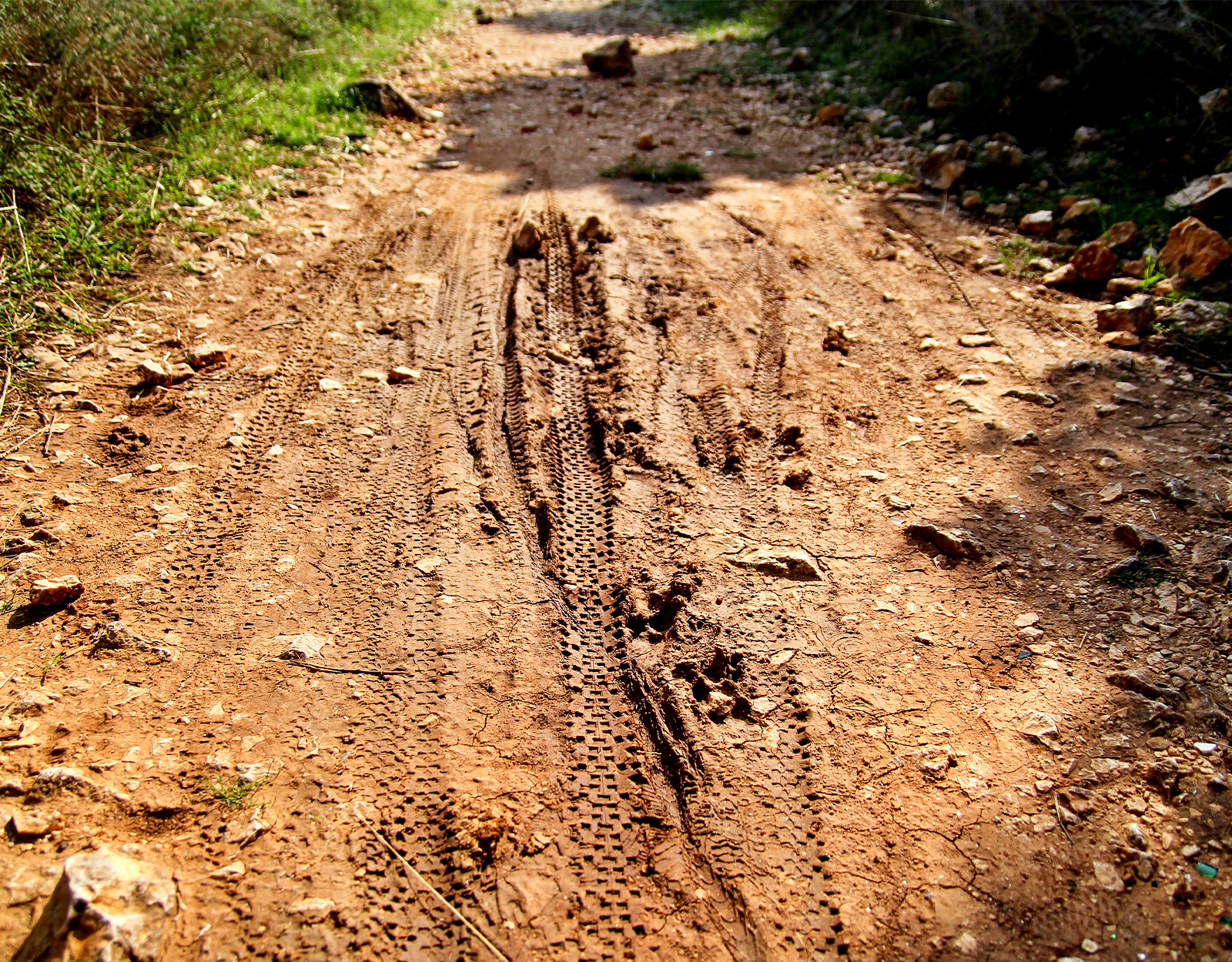
One of the first things new e-bike riders notice is that “pedal assist” is always there for you, even if you don’t expect it. It’ll kick in even when pedaling to keep your balance while you’re making a turn, so it can be surprising to have a sudden increase in speed while navigating a tight turning radius sitting atop a heavier-than-normal bicycle. Practice these turns, a lot.
E-bikes have different effective ranges for a single charge. QuietKat’s Apex Pro has a range of 25-52 miles using a 1000-watt motor powered by a 17.25AH/48V battery with 828 watt hours.
Like all electric vehicles, range is affected by a huge assortment of variables (hence the 25-52–mile spread in the QuietKat). Headwinds? Additional weight? Lots of hills? These can all have significant impacts on range, as will the level of assist the rider chooses. Another consideration particularly for hunters is cold. Batteries don’t like cold temperatures and if you’re out for the night you could wake up to considerably less range than when you hit the sack. If you’re planning a multi-day hunting trip, it’s pretty simple to remove the battery from the bike so you can keep it a little warmer in the tent or sleeping bag. If weight is less of a concern, you could always pick up a spare battery and bring it along too.
Battery- and motor-maker Bosch has a nifty little range calculator to help visualize how various terrain and other considerations affect range. Even if your bike doesn’t feature a Bosch drive, it’s an illustrative tool to help you think ahead to what you might encounter in the field and plan accordingly.
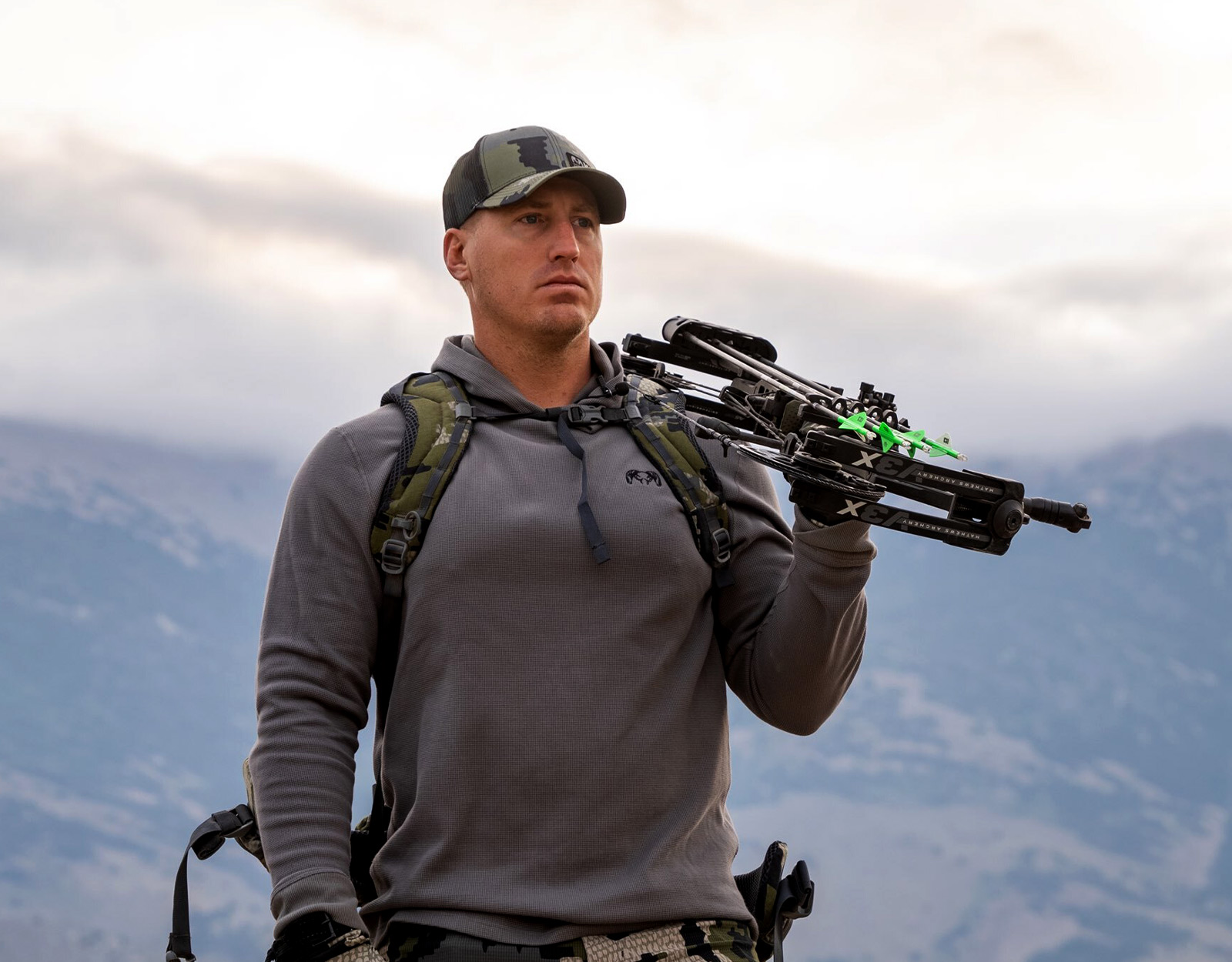
What Hunters Say About E-Bikes
When it comes to taking e-bikes into the field for hunting, Jeff Althoff of Love The Grind TV knows just how to make the most of them. Here we ask Jeff about his experience with e-bikes for hunting:
How have you been using e-bikes for Love The Grind TV and Homegrown Outfitters?
We’ve got a fleet of QuietKat Apex Pros in Wisconsin, Kansas, and some in Iowa, and we use them in many different ways. We use them throughout the course of the year. Starting in late winter and early spring, we’re using them for shed hunting. We found that we can cover a lot more ground a lot more effectively with e-bikes. You know, searching a five, 10, or 15-acre food plot may take a couple of hours by foot but with an e-bike we can zig-zag over the ground, tracking ourselves with onX Hunt, to make sure we’ve covered every part of the field.
After shed hunting, where do you take your e-bikes?
We’ve started turkey hunting with them this year in Iowa and Wisconsin. I can tell you it’s helped drastically. Not only did it put less wear and tear on the body, but it was so much more time efficient and you could get closer to where turkeys were roosting than you could by foot. We could easily take our gun and decoys, load them up on the e-bike, and drive from the truck straight to our hunting spot pretty quick.
Then guess what, when it gets light out and you think you know what the birds are going to do they do something different and you have to make a move. Nine times out of 10 turkeys do something different than they did the day before and you have to adjust. It’s a lot easier to do it on an e-bike. You might see a bird 600 yards away go into a draw and you can hop on the e-bike and cut him off in no time. Those e-bikes this spring gave us opportunities to harvest turkeys where we might not have gotten those same opportunities had we been on foot.
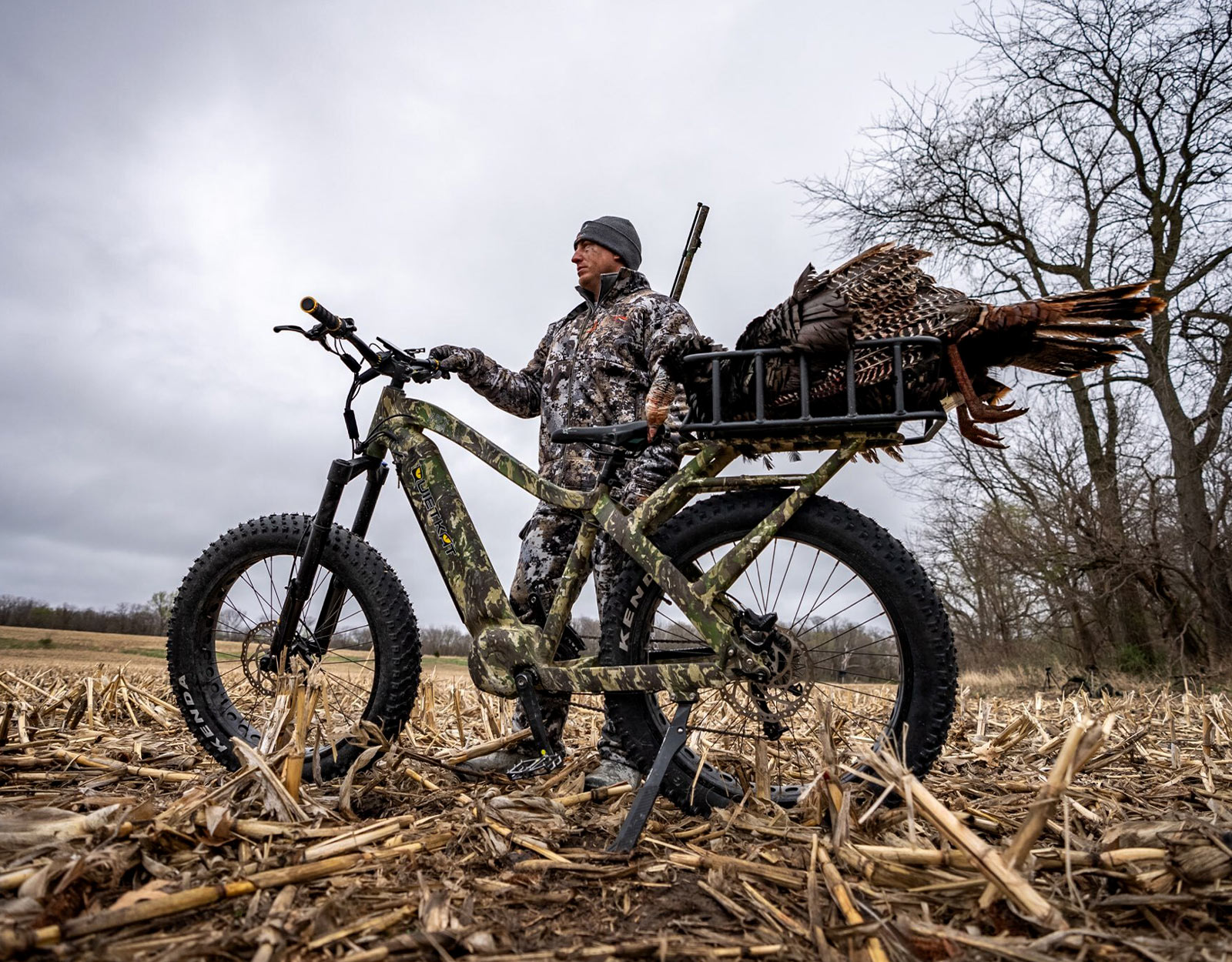
How have you used your e-bikes for non-hunting purposes?
We’ve definitely used them on some of our properties to help design them. In the early summer we’ll load up our e-bikes with stakes or ribbon and go mark our food plots. It’s so much easier to do with an e-bike. Sure, you can use an ATV, but if that ground’s wet and you don’t want to rip it up then an e-bike can be the way to go.
We’ve even put food plots in places where we’d never dare put them in the past because now we can access them to hunt those plots with an e-bike. We can get back to them more efficiently.
Then we shift ahead to trail camera deployment season. And whether we’re running a couple cameras or a whole network of cameras, we use those e-bikes quite a bit to haul our gear and be more efficient in placing our trail cams.
What is deer hunting like with an e-bike?
With deer hunting, access is everything. You can have the best hunting strategy, the biggest deer, and the best design, but if you screw up your access all that goes out the window. I can’t tell you the number of people whose hunts end before it even starts and they don’t even realize it because of access. If you’re hunting a specific deer and you blow that deer out on your way in, it could be days or weeks before you have an opportunity at that deer again.
Mature bucks are not forgiving. Two- and three-year old bucks can be forgiving, but if you want to have opportunities at mature deer you have to be really smart with how you access a property.
I firmly believe that if a mature deer sees that e-bike they’re not going to get up and run. They’ll be a little forgetful, and I don’t think anything changes with what they do that morning or that evening. But if they see someone walking and hear that “crunch, crunch” that’s drastically different. We’ve seen this happen over many years on many of our properties, mature deer treat seeing someone walk differently than someone riding a bike or a tractor, let’s say.
Now you can ride through a valley or to a spot and if a mature deer lays eyes on you, from a distance of course, they will treat that situation way differently, especially when you take the noise out of the equation that you might have with an ATV or a tractor. E-bikes are pretty bulletproof from an access point of view.
What advice do you have for those who are new to e-bikes or considering getting one?
They’re definitely a lot of fun. I think the first thing you’re going to realize is that the learning curve on an electric bike is so small. It’s so easy to get on an e-bike and start using it. It doesn’t really matter your age or background or experience level. You’re going to be able to get on it and learn pretty quickly.
The biggest “ah ha” moment my team and I had when we started using e-bikes is the time they save. Like before when it took us 20 minutes to get back to that ladder stand on the ridge and now it takes us two minutes, we were saying, “Holy cow, that’s quick.”
My biggest tip is to just have fun with them. Don’t get an e-bike and make your hunt the first time you use it though. Ride it in the off-season and get to know it.
Author’s Thoughts
There’s an allure to hunting with an e-bike I could not resist. I have hunted in the hills of western Montana for over 20 years now and covered many miles in boots. Once or twice I’ve tried riding a mountain bike for a hunt, pulling a trailer, but the snow was unforgiving. The e-bike, in my mind, would allow me to invest more of my energy into the stalk and laborious task of field dressing (should I be so lucky) and pack out back to the bike. It was time to ride, assisted.
I would consider myself having above-average familiarity with bicycles and bicycling. I’ve done some multi-day, self-supported touring. I’ve trained for and completed a handful of century rides and, at times, been a committed bicycle commuter. I spent a summer as a “Bicycle Ambassador” and worked for a renowned outdoor retailer for five years fitting people for and selling bikes. Heck, my partner even has a Peloton bike I hop on every once in a while.
I also own and ride a dual-sport motorcycle, having completed Basic and Advanced Riding courses.
Adding a hunting e-bike to the wheeled arsenal this year has been in one word…fun!
Out-of-the-box assembly of the Apex Pro was straightforward and simple, thanks to the video series easily accessible via included QR codes, though I did own and use a home bike repair stand. All the needed tools were supplied, except for bike grease. I was able to do everything by myself, but it would have been fun to have a buddy around.
Standing about one centimeter short of six-foot, I went with a medium frame size. As noted above, e-bikes are heavier than standard bikes so it’s easier to wield a slightly smaller frame than a slightly larger frame. I’ve been happy with that choice.
On my first long ride I whipped out 15+ miles and it felt like five. I covered everything from pavement to muddy trails and it felt stable even at higher speeds. For transport to/from trailheads, I got the Fat Bike Kit for my Yakima bike rack, as well as the RampUP ramp (though there’s a nifty way to get e-bikes onto racks without the ramp). FYI, now’s a good time to check your bike rack’s maximum weight limit.
I’m excited to explore even further this scouting season and next hunting season than I have before, backed by the confidence of covering more miles more efficiently and quietly. If you’ve recently purchased a hunting e-bike, drop me a note and let me know how it’s going for you.
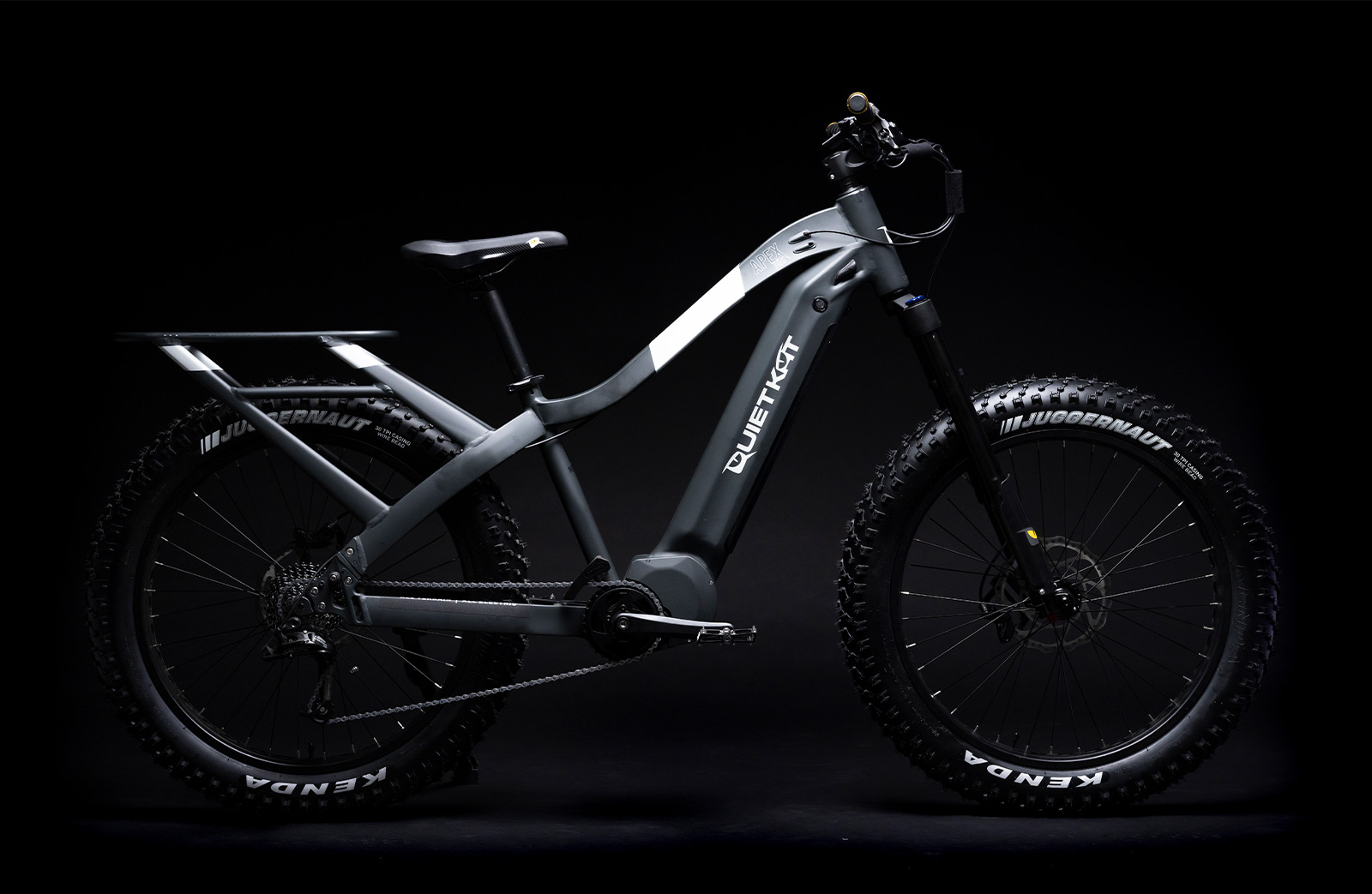
Shopping for an E-Bike
Convinced that an e-bike is right for you? A quality electric bike isn’t cheap—and it’s still a bike—so there are some considerations any buyer (especially someone who hasn’t purchased a bicycle in a while) should keep in mind before dropping a few thousand dollars on their new hunting companion.
Buying Direct vs. Local Bike Shop
Consumer-direct e-bike brands will almost certainly offer cheaper options, and plenty of quality bikes can be shipped to your door. But before you click, make sure you’re confident in your fit (see more below) and your ability to not just assemble the bike, but perform basic maintenance. Local shops will usually work on direct-mail bikes if you have an issue, but don’t expect a red carpet experience for a bike bought elsewhere.
Local shops can help you ensure a good fit, provide maintenance and ongoing support, and offer the chance to test-ride, but it won’t come free. You can expect to pay a little more via a shop and depending on their inventory, might have to wait a bit for a special order if you need a different size or specification.
Some brands split the difference and you can order online and have the bike delivered and built by a local shop (or powersports dealer, some of which carry e-bikes). As a general rule, if you’re confident in exactly what you want and what size you want it in, the web is a great option. If you’re on the fence or don’t know where to start for a high-dollar purchase, head into your local shop and leverage their expertise.
Sizing and Fit
An e-bike is still a bike, and you’re gonna have to pedal it. That means you need one that fits. And fit is about more than just your height—if you plan to spend some long miles in the saddle, you’ll want to be in a comfortable and efficient position so you don’t arrive at camp or a boundary gate only to find you’re so sore and tweaked that your hunt is compromised.
At their simplest, bike sizes mimic t-shirt sizing: small, medium, large, etc. And often that’s enough to get close, though if you have particularly long legs or a very short torso relative to your height, you might consider sizing up or down accordingly. Other considerations for a good fit are cockpit parts like the saddle, stem, and handlebar, which can drastically change your position on the bike from upright (easier on the back, harder on the backside) to stretched out (you’ll need to be limber and your hands will take more weight). A good local shop can help get you set up on the bike, ensure your seat height is keeping your pedal stroke efficient, and swap out parts to change a fit as needed.
Specifications
Like any piece of gear, you get what you pay for. And you can get a lot more value for your money if you know what you’re going to be using it for. Bigger batteries and more powerful motors can provide more range and oomph, but come at a cost to your wallet and often in weight. A fat-tired off-road model might not be necessary if your planned access route is smooth doubletrack, likewise if you’re planning to haul out an elk you’re going to want to think through how much power you want (and maybe shop for trailers).
In general, one of the biggest differences between premium and budget options is weight: you’re spending more to save more. It’s easy to fixate on weight—and certainly it affects not only range and maneuverability, but also basic logistics like hoisting onto a car rack or squeezing through a packed garage—but for plenty of hunting applications a heavier e-bike won’t make much of a difference. Consider your planned usage and be honest about what you really need.
Beyond the Bike
You don’t have to dress up like a Tour de France racer to be comfortable on a bike, but making a few concessions to cycling-specific clothing could make a big difference when it comes to comfort. Consider buying a chamois to wear under your camo. Sure, they can feel like an adult diaper, but plenty of science goes into the padding (and wicking), and a number of very affordable versions are sold as “liners” designed to be worn under other shorts or pants. They’re mesh, breathable, and your backside will thank you.
Along those lines, consider some cycling gloves to keep your hunting gloves dry and maintain better feel on the controls. If you’re headed to the high country or into cold temps, equip your grips with “pogies” that you slip your hands into. Trying to operate brakes, shifters, and e-bike screens with bulky gloves isn’t just annoying, it can be unsafe.
Finally, wear a helmet. In many states and jurisdictions you’re legally required to, but it’s always a good idea. Especially on an e-bike—20+ MPH is fast enough to do serious damage. All cycling helmets in the U.S. are certified by the Consumer Product Safety Commission, but you should look for helmets highly rated by Virginia Tech’s helmet lab, which often feature additional technologies that can help protect against shearing impacts (like MIPS, which you can find on a huge range of helmets at varied price points) or offer better impact absorption materials. Find one that fits well and wear it!
FAQ
Yes, in many cases, but you must consider the size of the deer and the hills and terrain you’ll be covering, plus the capability of your e-bike’s motor. Quartering the deer and strapping it to the cargo rack or carrying in a pack, making multiple trips, might be a better solution. Or using a trailer to carry out the deer might make most sense. But don’t forget, added weight affects your e-bike’s range!
Range, durability, and big tires. Using an e-bike for hunting means you’ll be carrying more gear than when you are riding one around town, for instance. You’ll also be off pavement nearly 100% of the time. Find a sturdy bike that can get you where you want to go.
E-bikes are much, much quieter than ATVs, and should something fail, an e-bike is much easier to extract from the backcountry than an ATV.